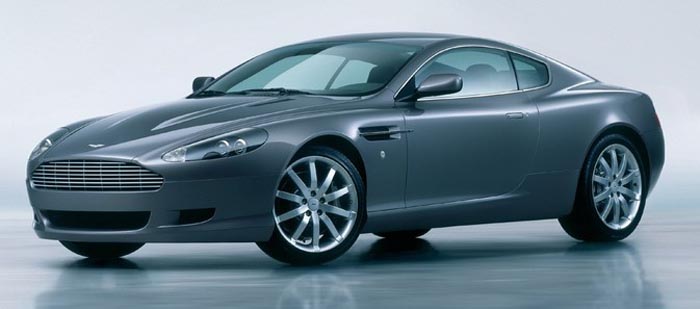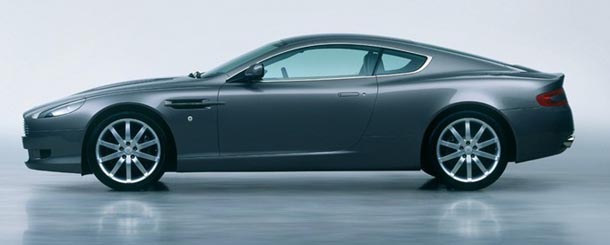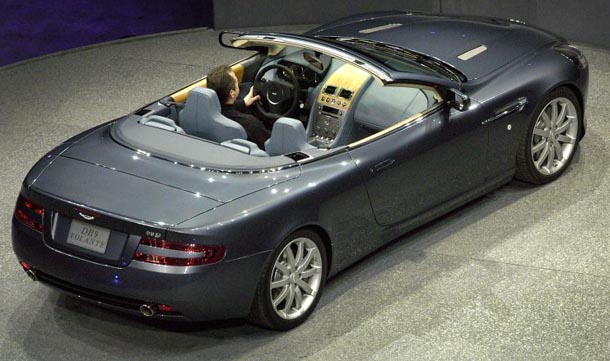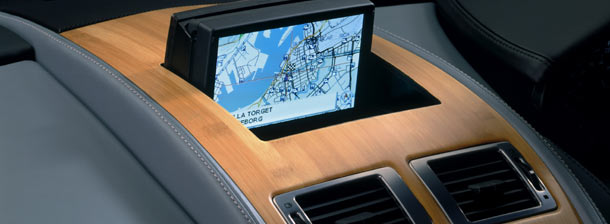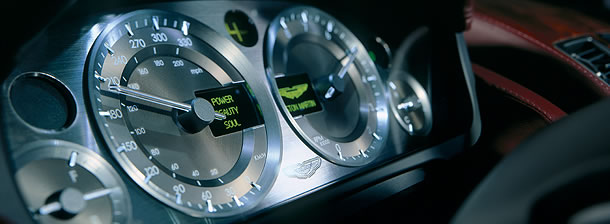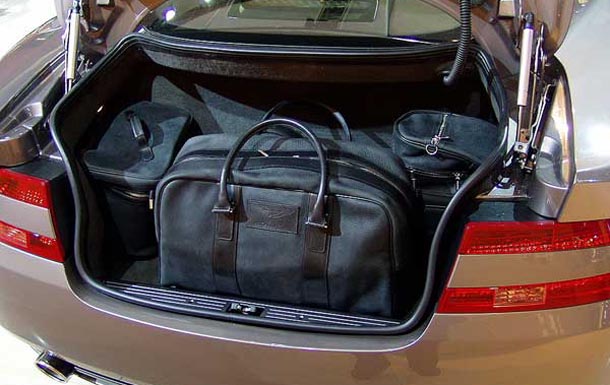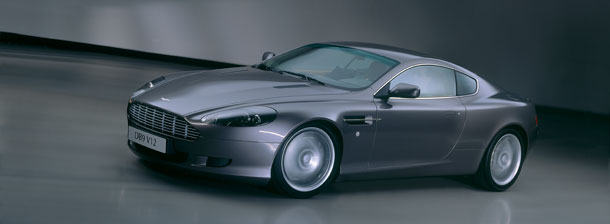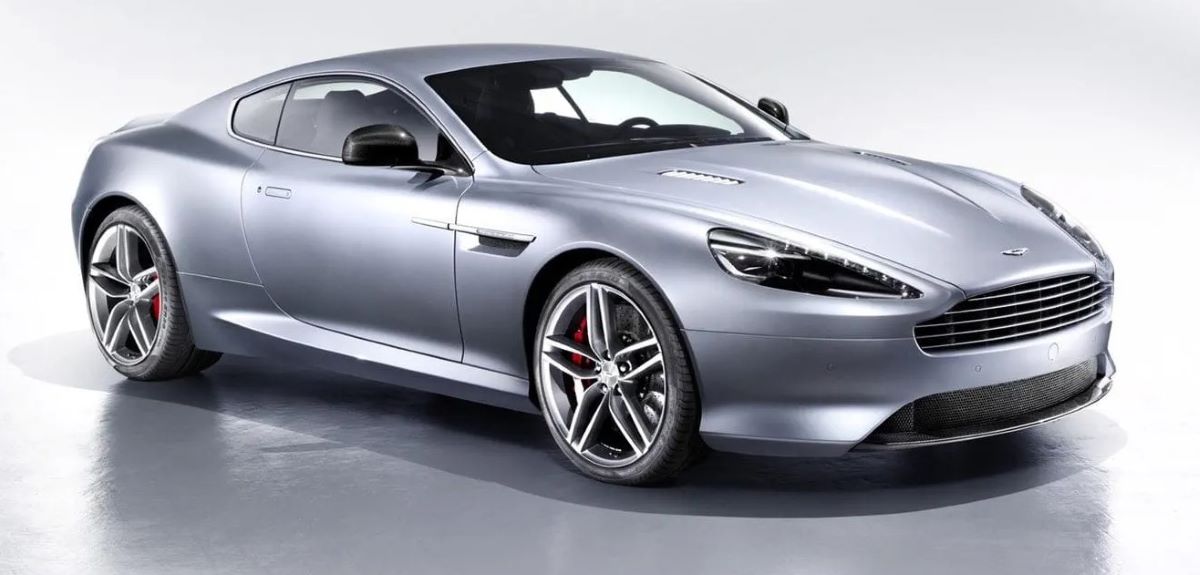
2005 Aston Martin DB9 – A thoroughbred sports car with GT levels of comfort and refinement
Sports cars are meant to be beautiful, and no maker of sporting cars has a better reputation for understated elegance and graceful styling than Aston Martin. Their beauty comes from harmonious proportions, a ground-hugging stance, taut surfacing, and thorough attention to detail. They are subtle, not attention-seeking. DB9 appears as if milled from a solid piece of aluminium.
Its side profile is typically Aston Martin: very clean, with a single sweep roofline. The uncluttered lines flow through to a distinctive tail, and the haunches on the rear wings are wide and curvaceous. Key Aston Martin design characteristics include the distinctive grille, metal side strakes and signature rear window shape
Aston Martins are not edgy. They don’t have sharp surfaces or pronounced power domes. The bodywork is gently curved, like an athlete with great muscle tone,’ explains Director of Design Henrik Fisker.
Great design, however, is not just about form; it is also about function. An Aston Martin is by definition very fast, so it needs to be aerodynamically efficient. It must be superbly stable at high speed – even the exhaust silencer is aerodynamically shaped to help achieve this.
The result is that DB9 drives arrow-straight at high speed yet, like all great Aston Martins, it does so with supreme elegance and grace.
It takes one push of a button and a mere 17 seconds to raise or lower the roof of the Volante. Hood up or down, the lines of a DB9 Volante remain breathtakingly beautiful.
DB9 was conceived and designed, from the outset, as both a Coupe and a convertible (Volante). This uncompromising approach is typical of the whole DB9 engineering philosophy. That is why DB9 Volante is one of the most structurally rigid and best handling convertibles in the world. It is also one of the fastest and quietest. It looks elegant and perfectly proportioned from every angle – with roof up or down.
DB9 Volante’s folding fabric roof is light, attractive and durable, and is also compact when stowed. There is no loss of practicality – DB9 Volante retains the rear seats, and offers the same boot space as DB9 Coupe.
The roof retracts fully, at the single push of a button, and swiftly stows beneath a hard tonneau cover that closes flush with the rear bodywork.
Safety is of course a major consideration. Special tilt sensors detect the danger of a possible roll-over and deploy two strengthened hoops from the rear seat headrests. Further safety protection is offered by the windscreen A-pillars, which can withstand more than twice the total weight of the car.
Great sports cars must handle superbly. They should respond quickly and predictably to driver commands; they should be nimble and agile.
The front-to-rear weight distribution of DB9 is a perfect 50:50 with 85 percent of the car’s mass sited between the front and rear axles. The aluminium V12 engine is mounted as far back as possible in a ‘front mid-engined’ layout. The compact aluminium transaxle housing the gearbox and final drive is positioned at the rear, forward of the rear axle.
A lightweight and rigid carbon fibre propellor shaft, housed in a cast aluminium torque tube, transfers torque from the front-mid engine to the rear-mid transmission. This gives DB9 its superb balance.
The result is a car that can be driven with great delicacy, a car that communicates richly through its steering, that is stable and predictable. DB9 excels not because it has myriad electronic controls added in an attempt to overcome compromise, but because it has an inherently light and stiff structure, perfect weight distribution and finely tuned suspension.
This lightness and balance make the whole driving experience more pleasurable – from the deft touch needed to open and close the elegant ‘swan-wing’ doors, to the touch and feel of even the most minor controls.
A great sports car needs a great engine – it is the heart of any high performance machine. In DB9’s case, that great engine is a powerful yet refined all aluminium 6.0-litre V12. It produces 335 kW (450 bhp) and 570 Nm (420 lb ft) of torque. That results in a power to weight ratio of 194 kW/tonne (263 bhp/tonne) – one of the highest figures in its class.
Performance is enormous, yet usable. Top speed is 300 km/h (186 mph) and acceleration sees 0-100 km/h (62 mph) in 4.9 seconds (add two tenths of a second for the automatic). These figures are impressive and DB9 will respond with real passion
With 80 per cent of the V12 engine’s torque, or pulling power, available from as little as 1500 rpm the DB9 can also relax. Mid-range performance is astonishing, giving instant overtaking power almost regardless of engine speed, or even which gear the car is in.
DB9 offers a choice of two transmissions, both allowing the driver terrific interaction with the car. The six-speed ‘Touchtronic 2’ fully automatic transmission uses shift-by-wire technology, and replaces the conventional gear lever with dashboard-mounted buttons to select Park, Reverse, Neutral and Drive modes.
The result is sophisticated yet intuitive: quick and easy to use and providing instant response to driver input. If preferred, or where driving conditions tempt, magnesium alloy paddles, sited behind the steering wheel, enable instant, F1-style gear changes, providing the choice of rapid and involving fingertip gear changing.
Unlike many other sports GTs, DB9 also offers a six-speed manual gearbox, featuring a conventional gear change and new high-capacity, twin-plate clutch
More than any other quality, DB9 seeks to serve up the richest driving experience in the sports GT class. It serenades the driver with its balance of engine and exhaust notes; it scintillates with its performance and agility; it charms with its delicious blend of fluent steering and linear controls. And if you wish to relax and just enjoy a leisurely drive, you can indulge yourself with the superb, industry-leading Linn audio system and select the car’s full automatic transmission mode.
This match of performance and luxury is the reason why DB9 can be both out-and-out sports car and refined GT. The cabin of DB9 is built around the driver. You sit as low and as close as possible to the car’s centre of gravity. Combined with the rigid body structure and all-aluminium, double-wishbone suspension, the result is unfiltered feedback of the car’s dynamic behaviour
This rich two-way communication – car to driver, driver to car – is at the very core of DB9’s design philosophy. Aston Martins have always made great music. The V12 engine has been described as the finest-sounding engine in production. The exhaust is tuned not only to be efficient and ‘clean’ but to provide the appropriate musical accompaniment to the engine. Under hard acceleration, the engine growls in triumph. Yet, when cruising, the growl becomes muted and melodic.
The steering, power-assisted for lightness, is superbly responsive, helped by the car’s low weight and superb balance. The vast disc brakes – 355 mm diameter discs at the front, and 330 mm at the rear – are ventilated and grooved, to aid cooling and boost braking performance. Radially mounted four-piston monobloc calipers provide great stopping power with a firm yet progressive pedal feel.
An Elegant & Luxurious Cabin Hand-Trimmed in Natural Materia. DB9 is a luxurious sports car. It is supremely comfortable, with a cabin hand-trimmed in beautiful, natural materials – primarily wood and leather. There is the latest in modern technology, yet there are no superfluous controls or displays. There is a minimum of distraction. Even the satellite navigation screen motors seamlessly away when not in use.
Yet the car has very high equipment levels, as you would expect in a thoroughbred sports car with GT levels of comfort and refinement.
The cabin interior is handmade, from the cutting of the leather to the crafting of the wood. This is not done merely for ‘traditional’ reasons. It is done because a skilled craftsman can finish wood or leather better than any machine. The leather is particularly soft and supple, as you would expect of Aston Martin, and is used throughout the cabin.
Wood trims are inspired by quality, hand-finished furniture. There is a choice of three: walnut, mahogany and bamboo.
In every case, ‘single piece’ cuts are used, rather than tiny strips or thin appliqués. Crafting such large pieces of wood is only possible when done by hand.
The use of aluminium on the dashboard, in the instrument panel and for the door handles, reflects the widespread use of that beautiful and lightweight metal throughout the rest of the car. It is a stylish and contemporary metal, yet one steeped in automotive tradition. Even the starter button, the driver’s first interaction with the V12 engine, is beautiful, made from clear glass.

An Exclusive Sports Car Tailored for Individuals
Aston Martins are hand-built cars, made to order. This exclusive, bespoke tailoring philosophy means any combination of paint and leather trim colour is possible. That is the essence of hand craftsmanship; it’s what makes Aston Martin’s new Gaydon facility the Savile Row of sports car production.
There is, of course, an extensive palette of standard body colours and interior finishes. These have been specially chosen by Aston Martin’s team of designers, who have scoured the world to gain inspiration for colours, materials, surfaces and finishes.
Twenty-one paint colours, categorised as ‘contemporary classics’ and ‘fast track’, vary from subtle metallics to the brightest hues. Twenty shades of the finest, softest leather, eight colours of carpet and three choices of wood trim – walnut, mahogany and bamboo – complete the ‘standard’ choice. For DB9 Volante, seven roof colours are available, from black to sandstone.
DB9 is equipped with an industry-leading Linn 128 W audio system – the finest standard in-car entertainment available – including a six CD autochanger. Optional upgrades for the true enthusiast are available, to either the magnificent Linn 260 W system with Limbik 5.1 or the supreme Linn 950 W system with Dolby Pro Logic II. Other options include satellite navigation, reversing sensors, cruise control, personalised sill plaques, powerfold mirrors, heated front screen, tyre pressure monitoring and a bright finish grille.
Technical Innovation Tested Meticulously
DB9 is the most thoroughly tested and engineered car in Aston Martin’s history. It is also one of the most technically sophisticated cars in the world.
The long list of design and engineering innovations includes the Organic Electro Luminescent (OEL) displays in the instrument pack and centre console. These provide higher resolution, and improved clarity, compared with conventional electronic displays.
Other innovations include LED (Light Emitting Diode) rear lamps that project through a reflector, dispensing rays more evenly than other LED systems. They also react more quickly, giving earlier warning to following drivers when braking.
A work load monitor temporarily cancels low-importance warning information during spirited driving so as not to distract the driver. The propellor shaft is particularly innovative: it is manufactured from carbon fibre for lightness and improved transmission refinement.
A stunning DB9 design feature is the ‘swan wing’ doors, which open out and up, improving access and reducing the danger of the doors scuffing on high kerbs. DB9 also pioneers the use of ultrasonic welding, which is 90 per cent stronger than conventional spot welding, and results in a better finish, yet uses only 5 per cent of the energy.
DB9 prototypes were tested in locations as diverse as Nardo in Italy, Death Valley in the USA and inside the Arctic Circle in Sweden. In all, more than one million testing miles were covered.
Reassurance in an Unpredictable World
DB9 offers class-leading safety. Its structure is designed to provide a supremely robust passenger cell that cocoons its occupants who are further protected by extruded aluminium crumple zones front and rear.
Dual-stage driver and passenger airbags, seat-mounted side airbags and seat belt pretensioners offer further protection. In the Volante, rear roll-over hoops are automatically deployed, when required, from the rear headrests.
DB9’s active safety – the ability to help avoid an accident occurring in the first place – begins with its inherent agility and responsiveness. The lightweight, rigid body structure and superbly tuned suspension and steering are further aided by a host of advanced electronics. These include Dynamic Stability Control (DSC) and the latest-generation ABS brakes which, should the system detect loss of grip, combine to help keep the car stable and balanced.
Electronic Brakeforce Distribution (EBD) and Emergency Brake Assist (EBA) are also employed. EBD balances the front-to-rear braking bias, to give optimal braking performance. In an emergency, EBA sensors detect when maximum braking is required and automatically apply the appropriate force.
Although engineering development is carried out exclusively at Aston Martin, whenever appropriate solutions and expertise existed outside the company, that is where Aston Martin’s engineers turned.
For instance, Volvo in Sweden is recognised as the world leader in automotive safety engineering. All the safety systems used in DB9 have been designed and tested using Volvo’s latest safety technologies, best-practice design guidelines and advanced computer-aided engineering.
All crash and safety testing was conducted at Volvo’s world-renowned safety centre in Sweden, which has probably the best facilities in the world for all aspects of safety engineering and crash-test analysis.
DB9 is the first Aston Martin to be produced at the company’s new world headquarters in Gaydon, in historic Warwickshire. Gaydon is a dedicated, high-technology facility where DB9 is hand-built at a series of work stations by technicians and craftsmen. This hand-craftsmanship has nothing to do with nostalgia. Hand-craftsmanship can deliver superior finishes and unique design details. It can also deliver engineering and design solutions for an exclusive sports car that mass production would find impossible.
The ‘single cut’ headlamp apertures in the front wings remove the need for unsightly cut or join lines and can only be achieved using Aston Martin’s hand-build processes. Hand-painting and hand-finishing deliver a better paint finish than any mechanised process, and each DB9 benefits from 25 man-hours of painting, to ensure a perfect finish. Customer visits are welcome and form an important part of the unique Aston Martin buying experience.
Body
Two door coupe or convertible body style with 2+2 seating
Extruded aluminium bonded body structure
Aluminium and composite body panels
Extruded aluminium door side impact beams
Xenon gas discharge projector headlights (dipped beam), halogen projector headlights (main beam) with power wash
LED rear lights
Engine
All alloy, quad overhead camshaft, 48-valve, 5935cc 60° V12
Mid-front mounted, rear wheel drive
Engine management system with Neural Net misfire detection system
Fully catalysed stainless steel exhaust system with active by-pass valves
Compression ratio 10.3:1
Maximum power 335 kW (450 bhp) at 6000 rpm
Maximum torque 570 Nm (420 lb ft) at 5000 rpm
Acceleration (Coupe manual) 0-60 mph in 4.7 seconds 0-100 km/h in 4.9 seconds
Acceleration (Coupe automatic) 0-60 mph in 4.9 seconds 0-100 km/h in 5.1 seconds
Maximum speed 186 mph (300 km/h)
Transmission
Rear mid-mounted ‘Touchtronic 2’ six-speed gearbox with electronic shift-by-wire control system
Rear mid-mounted six-speed manual gearbox
Limited slip differential
Final drive ratio 3.07:1 (auto) 3.54:1 (manual)
Steering
Rack and pinion, Servotronic speed-sensitive power-assisted steering, 3.0 turns lock to lock Column tilt and reach adjustment
Suspension
Front: Independent double aluminium wishbones incorporating anti-dive geometry, coil over aluminium monotube dampers and anti-roll bar
Rear: Independent double aluminium wishbones incorporating longitudinal control arms, coil over aluminium monotube dampers and anti-roll bar.
Brakes
Radial-mounted four-piston monobloc calipers, Anti Lock Braking System (ABS), Electronic Brakeforce Distribution (EBD), Emergency Brake Assist (EBA), Dynamic Stability Control (DSC) and Traction Control
Front: Ventilated and grooved steel discs 355 mm diameter
Rear: Ventilated and grooved steel discs 330 mm diameter
Wheels & Tyres
Lightweight aluminium alloy wheels
Front: 8.5J x 19
Rear: 9.5J x 19
Bridgestone tyres
Front: 235/40 ZR19
Rear: 275/35 ZR19
Interior
Full grain leather interior
Walnut facia trim
Driver and front passenger dual-stage air-bags
Front occupant side air-bags
Automatically deployed roll-over bars (Volante)
Ten-way electrically adjusted seats (including height, tilt and lumbar adjustment)
Heated rear screen
Automatic temperature control
Organic Electroluminescent (OEL) displays
Trip computer alarm and immobiliser
Remote-control central door locking and boot release
Battery disconnect switch
Battery conditioner
Tracker Horizon (UK only)
In-Car Entertainment
Linn 128 W audio system with radio and six CD autochanger
Dimensions
Length: 4710 mm
Width: 1875 mm
Height: (Coupe) 1270 mm
Kerb weight: (Coupe) 1710 kg (manual) 1800 kg (automatic)
Front track: 1570 mm
Rear track: 1560 mm
Turning circle: 11.5 m
Fuel tank capacity: 80 litres (17.6 Imp. galls. 22.0 US galls.)
The first car to be built in Aston Martin’s new factory at Gaydon in Warwickshire was the 2+2 DB9, a direct successor to DB7. The new car was considered to be such an advance on the old that Aston Martin had decided a straightforward sequential numbering would be considered inappropriate, hence why it was not titled DB8.
DB9 launched to acclaim in 2003 at the Frankfurt Motor Show with a Volante following in 2004. Powered by a V12 engine, this was also the first Aston Martin to be developed on the VH (Vertical / Horizontal) Platform which underpinned all Gaydon produced cars.
It was all new, designed from the ground up, the fruit of a million-mile test programme that had seen prototypes proved in locations as diverse as Death Valley in the USA, inside the Arctic Circle in Sweden and on the high-speed test track at Nardo in Italy. Other tests had taken place on Ford’s renowned Lommel proving ground in Belgium and at the Volvo crash test safety centre in Sweden.
Amazingly, DB9 was such an advance over DB7 that its bodyshell weighed 25 per cent less yet had twice the torsional rigidity, thanks to its aluminium bonnet, roof and rear wings and composite construction front wings and boot lid.
Following iterations of DB9 continued to improve the Aston Martin flagship. A powerful AM11 V12 engine increased power to 517 ps, with torque of up to 620 NM. Advanced carbon ceramic brakes gave DB9 a better response with a longer life, as well as improved performance with virtually no fade.



